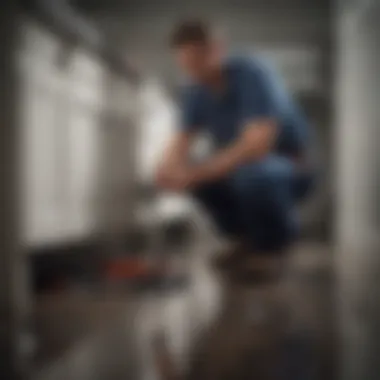How to Fix a Non-Draining Bathroom Tub


Intro
A non-draining bathroom tub can be a source of frustration for many homeowners. This issue often arises from a variety of causes, some easily resolvable, while others hint at deeper plumbing problems. It is essential to understand not only the potential reasons behind this issue but also effective solutions to mitigate it. This article aims to shed light on common culprits, practical fixes, and strategic advice for when professional intervention becomes necessary.
When faced with a clogged tub, the first reaction might be panic. However, identifying the source of the clog is the first step towards understanding the problem better. Hair, soap scum, and other debris frequently contribute to this everyday inconvenience. Additionally, complex issues such as broken pipes or improper installations can arise, demanding a more structured approach to resolution.
Homeowners can lead themselves through the troubleshooting process by following detailed insights and guidance, aiming for a fully-functioning bathroom tub.
Common Causes of a Clogged Tub
The reasons your bathroom tub might be struggling to drain are various, yet they can be classified into a few key categories:
- Hair Build-up: One of the primary reasons for clogs in the bathroom tub is hair. Hair strands can accumulate over time, creating thick mats that obstruct the flow of water.
- Soap Residue: Soap scum can also lead to blockages. Over time, it can combine with hair and other materials, forming a hardened mass that will not dissolve easily.
- Mineral Deposits: Water hardness leads to mineral buildup, which can further complicate drainage issues.
- Foreign Objects: Items inadvertently dropped into the tub can also block drainage systems.
- Plumbing Issues: Sometimes, the problem lies deeper within the plumbing system, where leaks or misalignments may cause drainage issues.
Understanding these causes allows homeowners to determine the best course of action before resorting to more intensive measures.
Diagnosing the Problem
To effectively resolve drainage issues, it is essential to diagnose them accurately. Here are some steps to take:
- Visual Inspection: Start with a close examination of the drain area. Look for visible clogs or any unusual signs that might indicate deeper issues.
- Check the Drain Screen: Ensure the drain screen or stopper is clean and functioning correctly. Sometimes, this minor component may be the only obstacle.
- Use the Plunger: A plunger can be a useful tool for loosening minor clogs, especially when push and pull motions are applied.
- DIY Drain Cleaners: Some homeowners opt for vinegar and baking soda solutions, which can break down organic materials effectively.
If these steps do not yield results, it may be time to seek professional help.
When to Call a Plumber
There are critical indicators that suggest a more severe underlying issue that warrants calling a plumber:
- Repeated Clogs: If the tub continues to clog despite your best efforts.
- Slow Draining Over Time: Gradually slowing drainage can imply a significant buildup somewhere in the plumbing system.
- Backups: If water backs up into other drains when the tub is used, it may indicate a central plumbing problem.
- Foul Odors: Unpleasant smells can often signal decomposition or bacterial growth due to standing water.
In such cases, professional help can assess the situation more thoroughly and provide solutions to restore functionality.
Culmination
Understanding the reasons behind a non-draining bathroom tub empowers homeowners to take proactive measures against this common issue. By recognizing typical causes and practicing effective troubleshooting steps, one can often resolve simple problems. However, understanding the boundaries of when to step back and seek professional insights may ensure that the plumbing remains in optimal condition. By equipping oneself with knowledge, homeowners can tackle these issues head-on, keeping their bathrooms functioning smoothly.
Preamble to Tub Drainage Issues
Understanding the reasons your bathroom tub is not draining is crucial for homeowners and those responsible for maintaining residential spaces. A non-draining tub can lead to several inconveniences, from unpleasant odors to potential water damage if left untreated. This issue can escalate quickly, turning a simple annoyance into an expensive repair.
Recognizing the underlying causes of drainage problems is the first step. This section aims to illuminate the common issues that can affect tub drainage. Focusing on these causes enables homeowners to make informed decisions regarding maintenance and repairs.
In addition, knowing the importance of timely intervention can save money and time. Proactive measures can prevent tiny problems from expanding into significant ones.
Moreover, this exploration into tub drainage issues contributes to a broader understanding of plumbing in general. It brings light to how various components of the bathroom interact and function together.
By familiarizing yourself with these drainage issues, you will not only enhance your home maintenance skills but also increase the longevity of your plumbing system. In a world where home repairs can often be overlooked, this knowledge serves as a powerful tool for effective property management.
Common Causes of a Tub Not Draining
Understanding the various reasons why a bathtub may not drain is essential for effective problem-solving. Identifying the cause can save time and prevent additional damage. Draining issues can stem from simple clogs or more complex plumbing problems. Recognizing these common causes enables homeowners to troubleshoot effectively, possibly avoiding costly professional interventions.


Clogs from Hair and Soap Buildup
One of the primary reasons for a tub's drainage failure is hair and soap buildup. Over time, tiny strands of hair wash down the drain along with soap residue. This mixture can create significant clogs. The combination of greasy soap and fine hair can stick to the pipe walls, forming a tough blockage. Regularly clearing this buildup can lead to smoother drainage. Homeowners can consider using a drain screen to catch hair before it enters the plumbing system. Simple maintenance steps can help mitigate this issue.
Blockages from Foreign Objects
Another significant cause of a tub not draining is the presence of foreign objects. Items such as toys, jewelry, or even small personal items can inadvertently slip into the drain. These blockages can create significant problems and may require immediate attention. If an object becomes lodged within the pipes, it can obstruct water flow entirely. Homeowners should check for any visible items in the drain and, if necessary, use a tool or vacuum specifically designed for drain cleaning. Taking precautions to prevent items from falling into the tub can also be beneficial.
Problems with the Drain Mechanism
Issues with the drain mechanism can also result in drainage problems. Components like the stopper, lift rod, or the entire drain assembly can malfunction. A compromised mechanism may fail to open fully, preventing water from leaving the tub. Observing how water flows when the drain is opened can provide clues. If there are any irregularities, the mechanism may need adjustment or replacement. Understanding how your specific drain mechanism operates is crucial for effective troubleshooting.
Pipe Issues and Plumbing Misalignments
Sometimes, the problem lies beyond the visible tub area. Pipe issues and plumbing misalignments can impede drainage. Deteriorating pipes, particularly in older homes, can become corroded or cracked. This deterioration can lead to significant blockages or even leaks. Misalignments in the plumbing system can cause sections of pipes to become angled improperly. Homeowners unaware of the internal structure of their plumbing may overlook this cause. Therefore, recognizing the signs of plumbing misalignment is essential for effective repairs.
Identifying the Nature of the Blockage
Identifying the nature of a blockage in your bathroom tub is a crucial step in resolving drainage issues effectively. When faced with a non-draining tub, understanding the specifics of the blockage can save you time and money. It aids in selecting the right tools and methods for repair, and it can help prevent future problems. This section will illuminate key elements that signal a blockage and provide insights into the tools available for diagnosing the issue.
Signs of a Drain Blockage
Recognizing signs of a drain blockage can expedite the problem-solving process. The following indicators usually suggest that your tub is suffering from a drainage issue:
- Slow draining water: One of the most basic signs is water pooling around your ankles when you take a shower. This occurs when water cannot pass through as it normally would.
- Strange odors: Unpleasant smells coming from the drain may point to decaying organic material within the pipes.
- Gurgling noises: If you hear unusual sounds, such as gurgling when water drains from other fixtures in the bathroom, this may indicate that air is trapped and that there is a blockage.
- Visible debris: In some cases, you may notice hair or soap residue in the tub or around the drain.
- Frequent clogs: Regular occurrences of clogs could mean there is a more significant blockage in the plumbing system.
These signs help determine if immediate action is necessary. Ignoring these symptoms can lead to more complicated plumbing repairs down the road.
Tools for Diagnosing Drain Issues
To properly diagnose drain issues, specific tools can assist in both identifying the blockage and clarifying its nature. You may consider the following:
- Plunger: A common tool that can provide insight into the blockage’s resilience. If a plunger does not dislodge the clog, the issue may run deeper than just hair and soap residue.
- Drain snake: This flexible wire tool can help in probing deeper into the drain, potentially discovering more severe blockages. It can reach and remove items that a plunger cannot.
- Wet/dry vacuum: This powerful vacuum can help remove debris from a clogged drain. It is particularly effective if the clog is not too far down the pipe.
- Camera inspection: A specialized camera can provide a clear view of the plumbing obstructed. This high-tech method offers insight into the exact location and nature of the blockage.
These tools enable you to gather information needed to understand the problem better and decide how to proceed.
Properly identifying the blockage type can minimize time spent and reduce costs associated with plumbing repairs.
In summary, recognizing the signs of a blockage and utilizing the right tools for diagnosis is essential for effectively addressing drainage issues in your bathroom tub. Taking these steps not only clarifies the current problem but also sets the stage for a sustainable solution.
DIY Methods for Clearing the Drain
DIY methods for clearing a bathtub drain are essential for homeowners seeking to resolve simple drainage issues without incurring high costs. Understanding these methods empowers individuals to maintain their bathtubs effectively and prevents future problems. This section outlines practical techniques to tackle clogs that often develop due to daily use. The benefits of DIY methods include cost savings, the ability to act swiftly, and gaining knowledge about household plumbing systems.
Using a Plunger
A plunger is one of the most straightforward tools available for resolving minor tub drainage issues. It works by creating a vacuum seal over the drain, allowing for quick bursts of pressure to dislodge blockages. To use a plunger effectively:
- Gather supplies: Ensure you have a clean plunger, preferably a flange type for improved sealing.
- Prepare the area: Remove any excess water from the tub if possible. This helps the plunger function optimally.
- Seal the overflow drain: Use a wet cloth or duct tape to block the overflow drain, ensuring all pressure goes through the clog.
- Plunge vigorously: Position the plunger over the drain and push down firmly. Pull back sharply, then push down again. Repeat this motion for several cycles.
If successful, the water should start to drain. If not, don’t despair; other methods may be necessary.
Employing a Drain Snake


A drain snake, or auger, is another effective tool for clearing more stubborn clogs that a plunger cannot dislodge. This flexible tool can navigate pipes to reach and remove obstructions situated deeper within the plumbing. To use a drain snake:
- Insert the snake: Feed the end of the snake into the drain gently and slowly.
- Rotate and push: As you push it further down, rotate the handle to allow it to latch onto the blockage.
- Remove the clog: Once you feel resistance, you’ve likely reached the clog. Pull back the snake while continuing to rotate it.
- Repeat if necessary: It may take several attempts to completely clear the blockage.
Using a drain snake requires some finesse, but it can be very effective for persistent problems.
Chemical Drain Cleaners: Pros and Cons
Chemical drain cleaners offer a quick solution for blocked drains. However, their use comes with specific considerations.
Pros:
- Effectiveness: Many commercial cleaners can dissolve organic matter like hair and soap scum quickly.
- Fast acting: Most products claim to work within minutes, providing immediate results.
Cons:
- Potential harm: These chemicals can damage pipes, particularly older or fragile systems.
- Environmental impact: Some formulations are harmful to aquatic ecosystems and require careful disposal.
When considering chemical drain cleaners, weighing the pros against the cons is crucial. They can be useful in specific instances but are not always the best choice for maintaining the long-term health of your plumbing system.
In summary, employing tools such as a plunger, a drain snake, or chemical cleaners can offer effective solutions to tub drainage issues while promoting regular maintenance that can enhance the longevity of your plumbing.
Preventative Measures for Future Drainage Problems
Addressing drainage problems in your bathroom tub is only half the battle. The other half lies in preventing such issues before they arise. With proper preventative measures, you can significantly reduce the chances of clogs and keep your tub functioning optimally. Here are some specific elements to consider.
Regular Maintenance Tips
Regular maintenance of your bathtub drain is critical. Some simple practices can help maintain drain health and avoid blockages. First, regularly remove hair and debris from the drain. A hair catcher can prevent hair from accumulating and help ensure effective drainage.
Another key practice is to perform a monthly flush of your drain with hot water. This simple act can help dissolve soap scum and grease build-up, which often contribute to clogs.
It's also useful to schedule an annual thorough inspection of your plumbing system. Having a professional check for potential issues can save time and money in the long run.
Best Practices for Drain Health
Maintaining optimal drain health requires integrating best practices into your routine.
- Limit Chemical Cleaners: While chemical drain cleaners may provide quick fixes, they can damage pipes over time. Instead, consider more natural alternatives such as vinegar and baking soda for periodic cleaning.
- Monitor What Goes Down the Drain: Be mindful of what you allow to enter the tub drainage system. Avoid washing down items like wipes, cotton balls, or food residue. Educate your household on proper waste disposal.
- Use a Drain Cover: Installing a drain cover will catch debris before it can enter the pipes. This small change can make a significant difference in maintaining drain health.
- Dealing with Hard Water: If hard water is an issue in your area, consider investing in a water softener. Hard water can accelerate mineral build-up in pipes, leading to more serious clogs over time.
"Prevention is the best cure; proactive measures can save homeowners considerable frustration and expense."
By adopting these preventative measures and best practices, you create a proactive approach to maintaining your bathtub. These steps can help you avoid costly repairs and ensure a smooth, reliable drainage experience.
When to Call a Professional Plumber
Understanding when to engage a professional plumber can be crucial for maintaining your bathroom tub's function. Often, homeowners may attempt to handle issues independently, which sometimes exacerbates the problem. Recognizing appropriate moments to seek help can save both time and money. The expense of a temporary fix can far outweigh professional services that ensure a long-term remedy.
Signs You Need Help
There are distinct signals indicating that your drainage issue has surpassed simple DIY measures. Some key signs include:
- Persistent Clogging: If your attempts to clear the drain have failed consistently over a short time, there is likely an underlying issue that requires expertise.
- Unusual Sounds: Gurgling noises or bubbling in the pipes could signal trapped air and more severe obstruction.
- Water Backflow: If water begins to pool or overflow in other parts of the house, particularly in adjacent fixtures, it may point to problems within the main plumbing system.
- Foul Odors: Bad smells emanating from the drain can indicate decomposition of organic materials or other serious plumbing issues.


Ignoring these signs might lead to more extensive damage or costly repairs, emphasizing the necessity of professional evaluation.
Choosing a Reliable Plumbing Service
Choosing the right professional plumber ensures that the issues are resolved effectively. Here are some tips to help you make an informed decision:
- Research Credentials: Check for licenses and insurance. Qualified plumbers need to have appropriate certifications to work on plumbing systems.
- Read Reviews: Look for feedback on platforms like Reddit or local service pages. Past customer experiences provide valuable insight into reliability and service quality.
- Inquire About Estimates: A trustworthy plumber should provide a clear, upfront estimate. This avoids surprise costs and helps you gauge their reliability.
- Evaluate Communication: A good plumber should explain the issues and potential solutions. Clear communication aids in understanding the work involved.
- Warranty Offerings: Check if they provide warranties on parts and services. This assures quality and accountability in their workmanship.
Finding a reliable plumbing service is essential for maintaining the health of your plumbing system. Taking the time to ensure the choice is informed can have positive long-term effects.
Cost Implications of Drainage Issues
Understanding the financial impact of drainage issues in your bathroom tub is essential for homeowners. Properly assessing the costs involved can help determine the more economical option between DIY solutions and hiring a professional plumber. Ignoring these implications may lead to further complications and increased expenses. The importance here lies in awareness and proactive management.
DIY Costs vs. Professional Fees
When faced with drainage problems, one of the primary considerations is whether to attempt a DIY fix or engage the services of a professional plumber.
DIY Costs:
Engaging in DIY repairs can seem appealing, especially for those with an inclination towards home improvement. The costs associated with DIY are often lower than hiring a plumber. Basic tools such as a plunger, a drain snake, or a chemical cleaner can be acquired for a relatively modest amount. Most plumbing supplies can range from $10 to $50, depending on what is needed.
However, expenses can escalate if initial attempts do not resolve the issue. Repeated purchases of tools or cleaners may add up, not to mention the potential cost of damages if the problem is worsened, requiring professional intervention later.
Professional Fees:
Hiring a plumber has a higher upfront cost. The rates can vary widely, depending on location, the complexity of the work, and the plumber's experience. Basic service calls can start around $75, but extensive repairs can escalate to several hundred dollars. While this might appear steep, the advantage lies in expertise and efficiency. Professionals possess the skills and tools to quickly identify and correct plumbing issues, often preventing recurring problems.
Thus, the decision between DIY and professional assistance hinges on the gravity of the issue, your confidence in performing repairs, and your budget constraints.
Potential Long-term Expenses
Beyond the immediate costs, it is crucial to consider the potential long-term expenses associated with drainage issues. Unresolved drainage problems can lead to more severe damage if ignored.
"Addressing drainage issues early can save both time and money in the long run."
Water Damage and Mold Growth:
If water accumulates in the tub or surrounding areas, it can cause structural damage to your home. Over time, this may result in mold growth, which can trigger health issues and necessitate costly remediation.
Pipe and Plumbing System Health:
Recurring blockages may indicate underlying problems within the plumbing system. Chronic drainage issues can lead to pipe corrosion, leaks, and ultimately the need for systemic replacement, which is significantly more expensive than a simple repair.
Utility Bills:
Leaky or ineffective drainage systems can also contribute to inflated water bills. Water that does not drain properly could lead to higher consumption levels and increased costs over time.
Considering these factors, it becomes evident that neglecting drainage issues is not just a short-term inconvenience but can mark the beginning of escalating financial burdens. Taking timely and informed action will help preserve both your bathroom's functionality and your financial health.
Finale on Tub Drain Maintenance
In summary, maintaining a well-functioning tub drain is pivotal for every homeowner. While drainage issues can stem from various sources, effective maintenance practices can significantly reduce the risk of future blockages. This conclusion underscores the importance of understanding drain maintenance in the context of overall home care.
Proper tub drain maintenance involves a few essential elements:
- Routine Inspection: Regular checks can help identify early signs of blockages or wear in plumbing.
- Immediate Action: Address small clogs as soon as they arise, using simple methods like plunging or employing a drain snake. This can prevent more significant issues down the line.
- Preventive Measures: Implementing best practices, such as installing hair catchers and ensuring no foreign items enter the drain, minimizes buildup.
Considering these elements provides several benefits. First, it promotes a cleaner bathroom environment, which cannot be understated in its positive impact on health and hygiene. Second, proactive maintenance tends to be more cost-effective compared to reactive plumbing fixes. Lastly, it enhances the efficiency of the plumbing system itself, leading to consistent performance without unexpected interruptions.
When assessing drain maintenance, some considerations are crucial:
- Evaluate the age of your plumbing; older systems often require more vigilant upkeep.
- Know when DIY methods may be insufficient, and recognize the signs that a professional plumber is necessary.
- Understand the typical costs associated with both DIY and professional interventions, allowing for informed financial planning.
Ultimately, a systematic approach to tub drain maintenance is beneficial for both the long-term performance of your plumbing and the overall comfort of your living space.
"Maintenance is not just about fixing issues; it’s about preventing them in the first place."
By focusing on these factors, homeowners can achieve a more reliable bathing experience while safeguarding their investment in their properties. With knowledge and careful attention, it is possible to prevent many drainage issues that tend to disrupt daily life.















